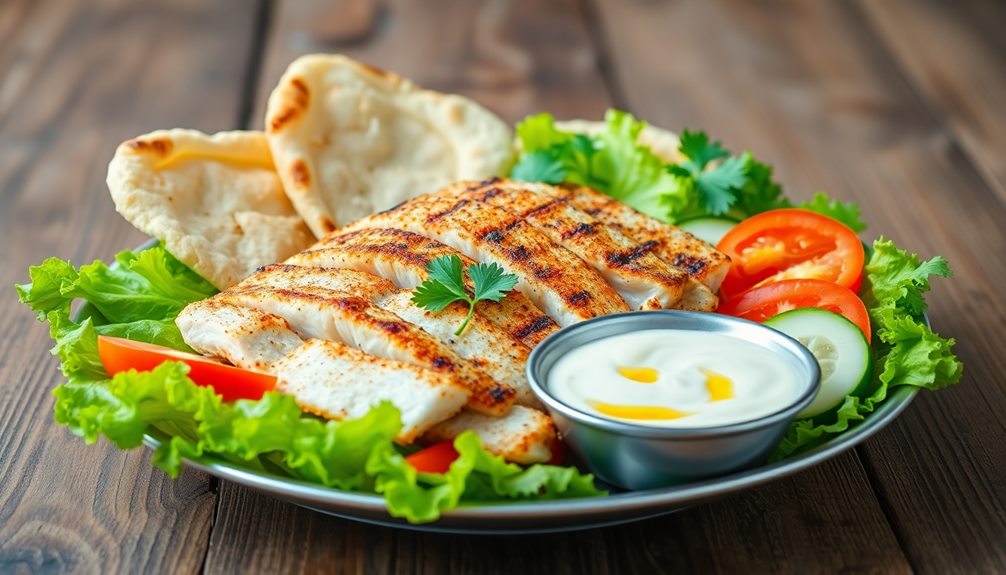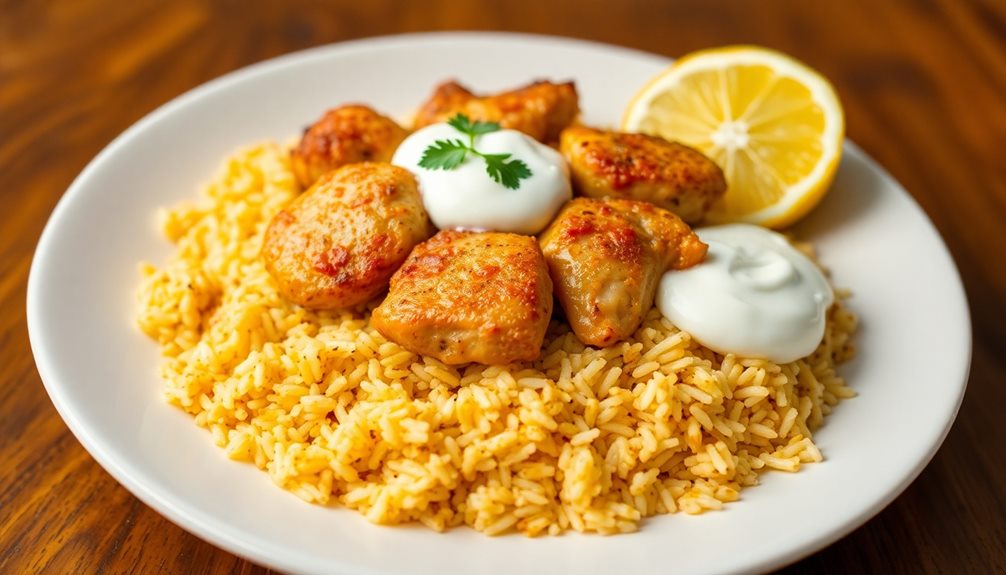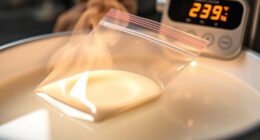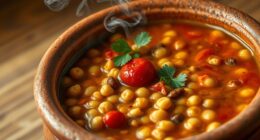Achieving crispy falafel without deep frying mainly depends on precise temperature control. When you keep the oil around 350°F (175°C) or bake at 400°F, it helps form a quick crust, sealing in moisture and preventing greasiness. Too hot, and the exterior burns before the inside cooks; too cool, and it absorbs excess oil. Maintaining steady heat guarantees a crunchy exterior and moist interior. Keep exploring to discover even more tips for perfecting your falafel technique.
Key Takeaways
- Maintaining oil temperature around 350°F ensures proper Maillard reaction and crispy exterior without excessive oil absorption.
- Preheating ovens to 400°F and brushing falafel with light oil creates a crispy crust without deep frying.
- Controlling pan or oven heat prevents burning and promotes even browning, essential for crispiness.
- Rapid moisture evaporation at optimal temperatures forms a crust that seals in moisture, reducing greasiness.
- Using precise temperature monitoring tools enhances texture and flavor, making falafel crispy without deep frying.
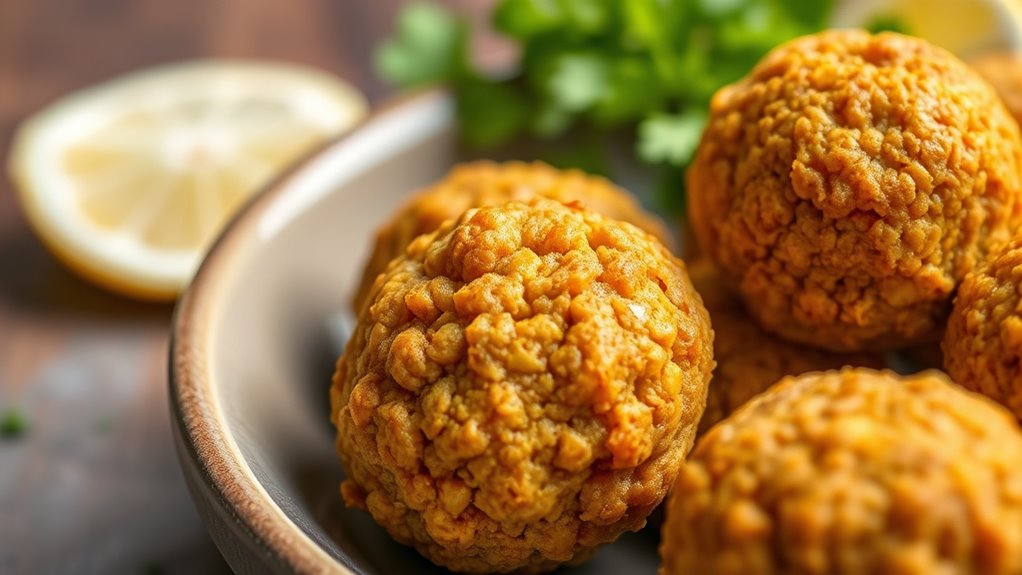
Crispy falafel is a beloved Middle Eastern treat that combines flavorful chickpeas with a satisfying crunch. Achieving that perfect crispness often involves deep frying, but with the right technique, you can enjoy crispy falafel without submerging your food in oil. Understanding the science behind oil absorption and temperature control is key to making healthier, equally delicious falafel.
When frying falafel, oil absorption is a vital factor. If the oil temperature is too low, the falafel soaks up more oil, resulting in greasy, soggy bites. Conversely, if the oil is too hot, the exterior may burn before the inside is fully cooked. To avoid these issues, you need to control the temperature precisely. Ideally, maintain the oil around 350°F (175°C). Using a thermometer helps you monitor the temperature accurately, ensuring your falafel cooks evenly and develops that golden, crispy exterior without excessive oil uptake.
Temperature control also influences the Maillard reaction, the chemical process responsible for browning and flavor development. When the oil is at the correct temperature, the falafel’s exterior rapidly forms a crispy crust, which acts as a barrier to oil absorption. This crust forms quickly because the high heat causes moisture on the surface to evaporate fast, creating a seal that prevents excessive oil from seeping in. If the temperature drops during frying, the falafel stays in oil longer, increasing oil absorption and leading to a greasy texture. Maintaining a consistent temperature allows you to achieve that ideal balance: a crunchy exterior and moist interior, without soaking up too much oil.
You can also adapt your method to make crispy falafel without deep frying by baking or pan-frying. When baking, preheat your oven and lightly brush falafel with oil, then bake at a high temperature—around 400°F (200°C)—until golden and crispy. This method relies on heat transfer rather than submersion in oil, but it still requires attention to oven temperature to prevent burning and ensure even crispness. Similarly, pan-frying with a small amount of oil demands careful temperature control to prevent sticking and uneven browning. Proper temperature management is essential in all these methods for achieving optimal texture and flavor. Additionally, using oil infusers can help infuse your falafel with herbs and flavors, enhancing the overall taste without increasing oil absorption. Paying close attention to heat management and oil control is essential for achieving perfect results every time. So, whether you’re frying, baking, or pan-frying, paying close attention to heat and oil management leads to perfectly crispy falafel every time.
Frequently Asked Questions
Can I Make Crispy Falafel Without Any Oil?
Yes, you can make crispy falafel without oil using oil alternatives like baking or air frying. These methods allow you to get that crispy texture while reducing fat intake. Plus, you can experiment with flavor variations by adding herbs or spices directly into the mixture or toppings afterward. Just keep an eye on cooking time and temperature to make sure your falafel stays flavorful and crunchy without the need for deep frying.
What Are the Best Substitutions for Traditional Deep-Frying Fats?
You can substitute traditional deep-frying fats with alternative oils like avocado, olive, or coconut oil, which are healthier options. These healthy fats can help achieve crispiness without the excess calories or trans fats found in some traditional oils. Just heat the alternative oil properly and cook your falafel until crispy. Using these substitutions not only improves health but also enhances flavor, making your falafel both tasty and nutritious.
How Does Baking Compare to Air Frying in Crispiness?
Baking vs air frying, it’s a bit of a toss-up when it comes to crispiness. You might think baking is a slow burn, but it can produce a satisfying crunch, though sometimes less evenly than air frying. Air frying circulates hot air, giving you a more uniform texture comparison and crispier results. If you’re after that perfect crunch, air frying tends to get you closer without the mess of traditional deep frying.
Does Using Gluten-Free Ingredients Affect Falafel Crispiness?
You might wonder if gluten-free ingredients affect falafel crispiness. Gluten-free textures can be a bit different, often resulting in less structure or crunch. However, ingredient substitutions like adding rice flour or chickpea flour help improve crispiness. You can still achieve a crunchy exterior by adjusting your method, such as baking or air frying, and ensuring your mixture isn’t too moist. So, with the right tweaks, gluten-free falafel can still be delightfully crispy.
Can I Prepare Falafel in Advance and Still Keep It Crispy?
Want crispy falafel anytime? You can prepare it in advance and keep that crunch by following smart storage tips. Store your falafel in an airtight container, and when reheating, use oven or air fryer techniques to restore crispiness. Avoid microwave reheating, which makes it soggy. With these tips, you enjoy fresh-tasting, crispy falafel whenever you crave it, without sacrificing texture or flavor.
Conclusion
Just like Icarus soaring too close to the sun, you can achieve perfect crispiness without the risk of deep frying. By understanding the science behind crisp textures, you’re now equipped to craft falafel that’s golden and crunchy, yet healthier. Remember, mastery comes from experimenting—so don’t be afraid to fly high with these techniques. With a little practice, you’ll be conquering the crispy falafel kingdom, proving that sometimes, less oil really is more.



